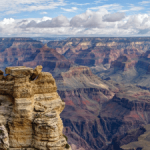
(This article is written by guest author Rob Wheeler. Information about the author below.)
At first sight prayer would seem to be impossible or meaningless for someone who takes up a Naturalistic stance towards the world. The Naturalist believes there are no objectively existing deities ‘up there’ to hear or respond to our prayer and so it must be a pointless exercise. But I think that takes a too narrow view of prayer. Even realist theists do not think of prayer simply in terms of cause and effect. When they pray for rain, as many will be doing at present in the face of the worldwide spate of wildfires, they are expressing hopes, wishes and desires, not invoking a magic spell. It is this kind of purely expressive prayer that is open to the Naturalist.
The key difference between the praying believer and the praying Naturalist is in the latter’s belief that the process of prayer is the important focus and source of benefit, not the reality of the person to whom you pray nor the direct effect prayer might have on the material world.
Praying Naturalists are not just non-believers hedging their bets, not quite sure of their non-belief and wanting to keep in with God, just in case He exists. Neither are they ‘atheists in foxholes’ who at a time of crisis turn in fear and panic to the God of their childhood. They are perfectly convinced that the supernatural is fantasy but see psychological value in the conscious and deliberate exercise of a conversation with an imaginary being.
The value of prayer is in having someone, even if it’s a fictional someone, to whom you can address your gratitude, excitement, joy, guilt, regret, sorrow, generosity, forgiveness, aspirations, hope, pain, worry, concerns, and sympathy. You can confide in them, express your resolution to act, and make promises to them. In their presence you can express your melancholy awareness of loss and mortality and the fragility and contingency of life.
It is in the act of verbalising and reflecting that the real value of prayer lies, not in getting ‘answers’. Often you don’t really know what you think or feel until you have spoken the words out loud. So prayer is an opportunity to articulate and express your thoughts and feelings and thereby come to understand them better. And in prayer you have no excuse for self-deception, dishonesty or prevarication as there is no one to hide from.
This process of talking to an imaginary ‘other person’ will not seem so strange when we consider it in the light of the traditional practice of writing a journal or diary and personalising it with a name. For instance you might start your diary entry ‘Dear diary…’. Anne Frank used to address her diary as ‘Kitty’. Regarding your diary as a listening friend makes it psychologically easier to write about your feelings and research has shown that journal writing can have positive therapeutic value.
Writing a letter to an imaginary or dead person, or a letter you never send, is another therapeutic exercise that patients in psychotherapy are encouraged to do in order to verbalise, clarify and defuse feelings.
In Gestalt psychotherapy patients are sometimes asked to talk to an empty chair and imagine they are addressing an aspect of themselves, a problem or a significant person from their past. An alcoholic may be invited to imagine their bottle of booze sitting in the chair and then asked ‘what would you say to it now?’.
In the movie Looking for Eric, the hero is introduced to a form of self-help therapy in which you are instructed to choose a role model who will be your imaginary counselor and adviser. The hero, named Eric, chooses another Eric, Eric Cantona the footballer, who pops up at various points in the film to warn, advise and inspire him, which evokes both humour and pathos. There is no suggestion that the Eric Cantona who is advising our hero is objectively real. He is a imaginary projection created by the hero providing a way of tapping into his own, sometimes unconscious, intelligence, insight and wisdom.
It is not uncommon for the bereaved to talk out loud to their deceased spouse’s photograph or grave without actually believing that they are present in some supernatural way. It is just the natural continuation of the previous relationship and talking in this way is purely expressive and cathartic.
What these examples serve to show is that talking to an imaginary person is not necessarily a sign of delusion, mental illness or escapism and might, in fact, be very helpful.
An imaginary god will do just as well as a real one as any ‘answers’ to prayer come ultimately from oneself anyway. In a sense, therefore, prayer can be said to ‘work’ but not as a form of magical technology intended to manipulate the material world, but rather as a form of emotional management and moral reflection. Regarded in this way the efficacy of prayer looks very much like the placebo effect where belief in the treatment is what makes it effective. But in the case of the Naturalist there is no belief in anything objective so how can it still work?
It turns out there has been research showing that in some cases, even where patients know that they are being given a placebo, they still report an improvement in their condition. One of the researchers, Ted Kaptchuk, suggests it is not the power of belief but the power of symbol and ritual that has the effect. Thus, in the same way that a fake drug can have a beneficial effect, even when it is known to be fake, a fake deity may be just as psychologically effective as a ‘real’ one!
In some ways prayer is like meditation in that it is a regular and disciplined period of time-out from the mundane concerns of everyday life but it probably works best for people whose ‘monkey-minds’ cannot abide staring at walls with their eyes half closed, silent and still.
Meditation is primarily about clearing the mind of distractions and developing single-pointed concentration. It aims at stilling the discursive mind, exploring the emotions and ultimately calming them. By contrast prayer is, by definition, discursive, redirecting the mind by filling it with images, words and ideas. It aims at stirring up and stimulating the imagination and passions rather than calming them.
Another pertinent difference between meditation and prayer is that while the meditator aims at being present in the moment, in prayer we also range over both the past (with gratitude and regrets) and the future (with anticipation, care and concern).
None of this is to say that prayer is better or worse than meditation. They are just different activities with different aims and there is no reason why someone should not practice both at different times.
Naturalistic prayer can be formal, as in Catholic liturgy where you recite previously written prayers, or it can follow the non-conformist practice of purely extempore utterance. The key point with beginning this type of prayer is to choose a deity that you can take seriously but in no way take to be real!
Learn about Membership in the Spiritual Naturalist Society
__________
The Spiritual Naturalist Society works to spread awareness of spiritual naturalism as a way of life, develop its thought and practice, and help bring together like-minded practitioners in fellowship.
Articles About Naturalists Who Pray
- Why I pray to Isis (Humanistic Paganism) by B T Newberg
- Non-theistic Prayer (Spiritual Naturalist Society) by J D Moyer
- Prayer: Yoga for the Heart (Patheos) by Roger Gottlieb
- The atheist and His Goddess (Psychology Today) by Christine Wicker
- Is faith the world’s most effective placebo? (OnFaith) by Sigfried Gold
- Atheist Spirituality (eSkeptic) by Siegfried Gold
- Why God is important (Spiritual Naturalist Society) by Sigfried Gold
- How to Pray If You’re an Atheist (Huffington Post) by Jerry Dewitt
- I Don’t Believe in God, But I Pray (The Fix) by Nathan Frank
- Philosophical Meditation (from the ‘Book of Life’ website)
- You don’t have to be religious to pray… but it helps (Guardian) by Julian Baggini
- Bowing before the personified impersonal: Prayer for an atheist Pagan (Patheos) by John Halstead
- Is Penn Jillette the World’s First Praying Atheist? (Big Think)
- Atheist Penn Jillette says it’s okay to pray, but not to God (Christian Today) by Czarina Ong
- An Atheist’s Prayer (Harvard Divinity School) by humanist chaplain Sally Fritsche
- When Atheists Pray (Religious Studies Project) by Sebastian Roth
- Atheist Prayers’ – When ‘Thoughts’ Are Not Enough (Huff Post) by Kester Brewin
- Should Atheists Pray? by Valerie Tarico
- An Atheist’s Prayers (KQED) by Ripudaman Malhotra
- I’m an atheist, but last month I prayed to “God” (a lot) (Patheos) by Martin Hughes
- A humanist’s guide to prayer (UU World) by Patricia Montley
Rob Wheeler’s CV
Rob Wheeler graduated many years ago from the University of Kent, Canterbury, UK, in philosophy and theology and since then has, at various times, been an assistant hospital manager, a social worker, an IT systems manager, a software developer and a college lecturer. He is now happily retired and living in south east UK, where he had been running a pub philosophy group called ‘The Stoa’ (stoa.org.uk) for the past 13 years and occasionally officiating at weddings, baby namings and funerals as a Humanist celebrant.

















